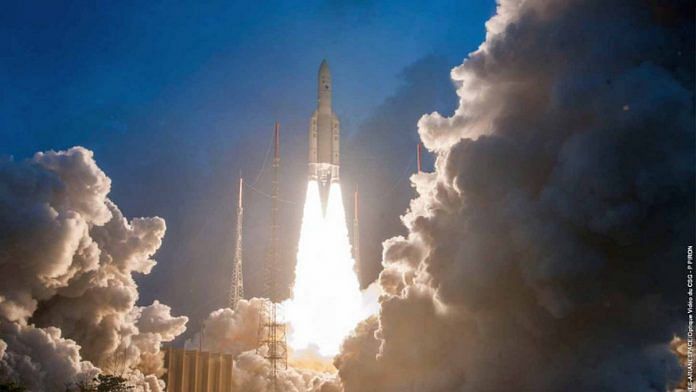GSAT-11, a satellite that will bring superfast internet to India’s remotest corners as well as beyond the mainland, was launched Wednesday morning.
Bengaluru: GSAT-11, India’s biggest satellite ever to be launched, took off on board the behemoth European Ariane 5 rocket from French Guiana in South America early Wednesday.
GSAT-11 is an advanced communication satellite that will orbit the earth with the express intent of providing improved broadband connectivity to the whole country.
A boost for Digital India
The satellite was due to be launched in 2016, but the project was repeatedly postponed for varying reasons, including design improvements.
A part of the BharatNet project, which stems from Digital India, GSAT-11 will provide broadband connectivity to rural and inaccessible parts of the country, and enable the latest in communication by providing in-flight connectivity. The ensuing broadband connectivity will cover not just mainland India, but also the island groups of Lakshadweep and Andaman & Nicobar.
“GSAT-11 is the third in a series of four high throughput satellites (GSAT-11, GSAT-19, GSAT-20, and GSAT-29) that will provide the country broadband connectivity of over 100 Gbps and will link rural areas and bridge the digital divide under the Digital India programme,” said ISRO chairman K, Sivan addressing the news media from Arianespace control room in French Guiana after the successful launch.
The satellite weighs 5,854 kg and has the largest solar panels ever for an ISRO satellite.
It also has the maximum communication antennae of any satellite India has launched: Five. It is a ‘multispot beam’ satellite and India’s first large high throughput satellite providing an output of 16 Gbps. This will come in handy when services utilise a high data rate.
The services will be provided using spot beams, ie, concentrated beams of connectivity with high strength. Spot beams allow satellites to transmit different data signals using the same frequency, as it would have only a limited number of frequencies to use. The narrower the beam, the more the energy.
Also read: The militaristic claims of ISRO’s latest satellite have been greatly exaggerated
Four ground stations
GSAT-11 uses the Ku and Ka bands of radio frequencies — while the Ku band uses the 12-18 GHz portions of the electromagnetic spectrum, Ka relies on the 26.5-40GHz.
There will be 32 spot beams in the Ku band focussing on different parts of the country, 16 each in vertical and horizontal polarisations. There will also be 8 hub beams, four in each polarisation, operating in Ka band frequencies.
There are four ground stations, one each in Delhi, Bengaluru, Ranchi, and Ahmedabad, which will communicate with the satellite and connect it with users. These hub stations are connected to each other by an optical fibre network for smooth connectivity.
The satellite bus – the spacecraft’s body – is built on ISRO’s new I-6K bus. There are up to 600 small subsystems in the satellite, with ISRO claiming that over 90 per cent of all the hardware has been realised in India with ample private industry participation. Several new assembly features are in use, such as power sharing between subsystems.
The satellite is still climbing in orbit after launch, using gravity assist over the next five days before reaching its final position. It will sit in a geostationary orbit of 35,786 km. The satellite payloads will subsequently be tested for 10 days before it begins operation.
Commercial launch services company Arianespace will also launch the two future satellites, GSAT-31 and GSAT-30, as the satellites are too heavy to be launched by GSLV, India’s largest carrier. Arianespace has so far launched 21 Indian satellites.
Also read: ISRO mission successfully places HysIS, 30 foreign satellites into orbit



